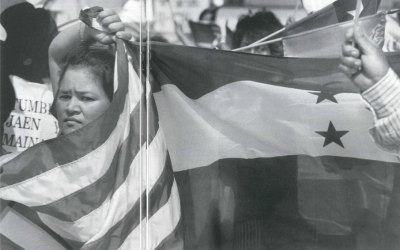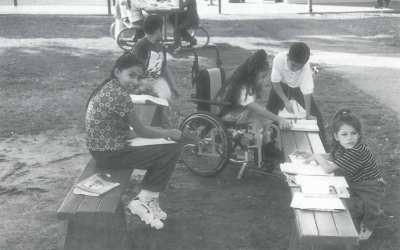From “Cuentos” to “Ciencias”
Reconciling Stories and Science
There’s the additional fear that my narrative will sound maudlin or romanticized. Perhaps so, but an essay of this type is not intended, to my way of thinking, to tell horror stories about myself. Rather, I approach this task with the conviction that I come from someplace special, even magical, if such a word is appropriate coming from an academic. I also come from some profoundly inspiring people, and those experiences have guided me down a research path that has been extraordinarily satisfying. This narrative, for me, renders transparent what is often opaque. Social scientists who study people, are, after all, people. In this brief narrative, my goal is to share some of the influences on my own work that derive from my background in the hopes that it might encourage all of us in the academy to share not only our research, but our humanity, with one another.
My colleague at The University of Texas at Austin, Vice President and Dean of the Graduate School Teresa Sullivan, once gave a talk to our graduate student cohort in which she pointed out that her introduction to sociology generated a profound personal discovery. She had always been a sociologist, even before she knew there was such a thing to be. This observation resonated for me as well. From the time that my parents divorced when I was a young girl, I began to become a sociologist.
Their divorce resulted in a move from the largely non-Hispanic white suburbs of western Chicago to my mother’s ancestral home of La Pryor, Texas 45 miles from the Mexican border (population 5000), where my grandfather was a foreman on a cattle ranch and my grandmother worked in the local public school cafeteria. For a short period of time, I remained the person I had been before these changes–a monolingual English speaker, an excellent student in school, a kid who rode bicycles, swam in city swimming pools, went to an Episcopal church, ate at McDonald’s.
But before long, everything began to change. My grandparents did not speak fluent English. So I learned Spanish, which was also the language of instruction in the public school I attended 15 miles away in Crystal City, Texas. Instead of bicycles, I rode the horses my grandfather broke to saddle for the ranch owner. Instead of pools, there was the Nueces River. Instead of the Episcopal Church, I spent my evenings in the bed I shared with my grandmother watching and listening closely as she lit her candles and said her nightly prayers in front of framed pictures of La Virgen de Guadalupe and Jesus Christ. There was no McDonald’s. Our meals were elaborate family get-togethers filled with jokes, songs, (a few fights over the size of the phone bill) and family stories, including some poignant ones. With great love in her voice, my grandmother would tell the story of her own youth, when she dressed her fatally ill 14 year old sister in a homemade wedding gown so that her sister could experience at least a part of something she would never come to know. My grandfather strummed his guitar and sang Cielito Lindo whenever he was in a particularly good mood, a song I sang to him in the hospital in the last days of his life in 1998.
Even the tragedy of the passing of the man my three children call “Cowboy Grandpa” had a few moments that bring smiles to our faces. For the last few months of his life, he was bedridden at home. This was torture to a man who had to be pulled off a tractor by my grandmother to come to my wedding rehearsal ten years before. Knowing how much my grandfather had loved to hunt, my mother went to Wal-Mart and bought a large cotton sheet stamped with images of white-tailed deer, which she tacked up on the wall at the foot of his bed. As he stared at the deer, he asked my Uncle Peter, his only son, “Which one of those do you think is the biggest?” Peter’s response was “I don’t know Dad, it’s a print. I think they’re pretty much all the same size.” My grandfather squinted closely at the sheet, raised his hand, and pointed to the one in the middle, muttering “Nope, I think that one’s bigger.” At which point, my beloved uncle said, “You know, Dad, I think you’re right.” This family taught me about family as everything from refuge to maelstrom of conflict, and their example makes me a better teacher and scholar, and evaluator of other researcher’s scholarship about Mexican American families.
And there were Mexican immigrants in my life, always, passing through the back trails and brush country of the ranch, cautiously approaching the house and asking for food and water in exchange for work. Most were young men (what we demographers now define as labor-force-aged target earners) who stayed only a few days as they made their way 95 miles north to San Antonio. Some were pregnant women. One was a teenage boy named Gregorio, a name shared by my grandmother’s own father, who lived with my family for the better part of a year, until an INS raid on the ranch took him away; and we never saw him again. When the immigrants were out with my grandfather doing the day’s work on the ranch, I would sneak into the small bunk house where they slept and read the prayers and examine the drawings they had penciled onto the walls. Never was there profanity or pornography. Instead, there were prayers beneath which were listed full names of parents, children, wives. There was poetry; there were corrido lyrics. There was a sense of community foregone in the interest of a difficult purpose.
It was not until I attended college that I found a discipline that focused on issues like community formation, the ways that populations are incorporated into labor markets, the gender roles that characterize families, international migration, and all of the many themes that had been a part of my life up to that point. That discipline was sociology, and I embraced its scientific rigor and its humanistic concern with the bettering of social conditions wholeheartedly. Finally, as the time for graduate school approached, I discovered that there was a strand of sociology that concerned itself, first and foremost, with population processes, migration included. I became a social demographer. Since that time, I have devoted much of my scholarly career to the understanding of how Mexican migration to the United States affects U.S. demographic composition, U.S. social institutions like the state, the school system, and the labor market. I have also dedicated much of my scholarly energy to understanding the particular roles of women in Mexican immigrant and Mexican American families, as they are (or I should say as we are) incorporated into labor markets while trying to carve out meaningful family lives for ourselves at the same time.
I owe a great debt to the people I come from, and to the people I am now coming to know through my scholarly travels and publications. The thread that links the past to the future, for me, is a thread woven of cuentos, of stories, some told with heart and humor, some told with regression coefficients, all told with the objective of broadening and deepening our collective understanding of the human condition. It is my fervent hope that in sharing some of my cuentos, I will have the opportunity to hear those of my colleagues and friends in this important community of scholars who dedicate their own lives to the understanding of the Latin American experience.
Susan Gonzalez-Baker is an assistant professor in the Department of Sociology at the University of Texas, Austin. She is also a Faculty Affiliate at the University of Texas Population Research Center and a contributor to Crossings: Mexican Immigration in Interdisciplinary Perspectives, edited by Mareclo Suarez-Orozco, (DRCLAS/Harvard University Press, 1998).
Related Articles
The ‘Return’ of the State
The oath which immigrants are required to swear today on becoming naturalized citizens of the United States, reads, in rather archaic and high-sounding formal language: “I absolutely and …
Nueva York, Diaspora City
New York magazine has been renamed Nueva York, at least for a week. The Spanish word on the cover of the 6 September 1999 issue is an eye-catcher for readers of the popular weekly, and …
Latin@s in School
At the beginning of this new century, we have become a far more racially and ethnically mixed nation, but in our schools, the color lines of racial and ethnic separation are tightening….




